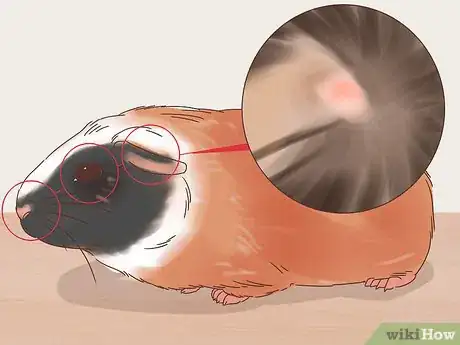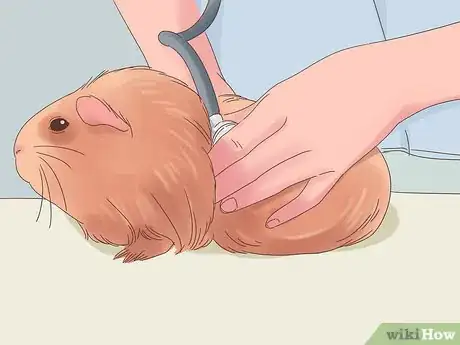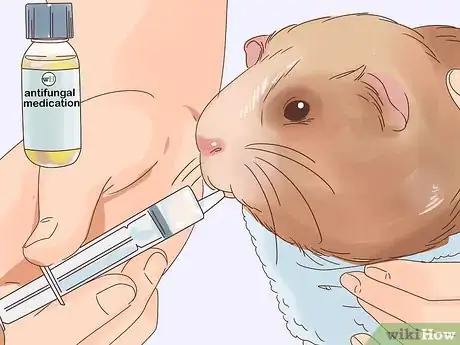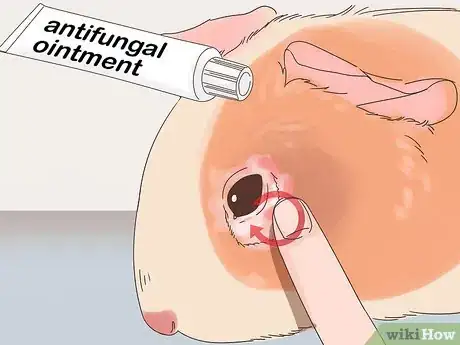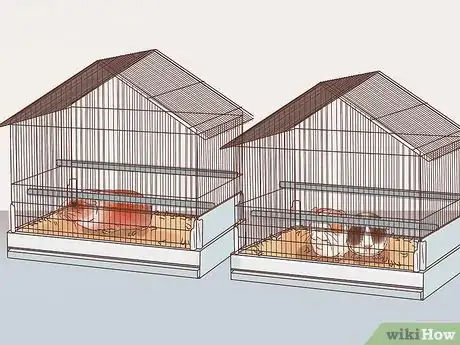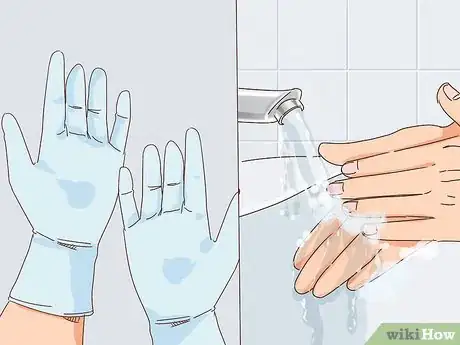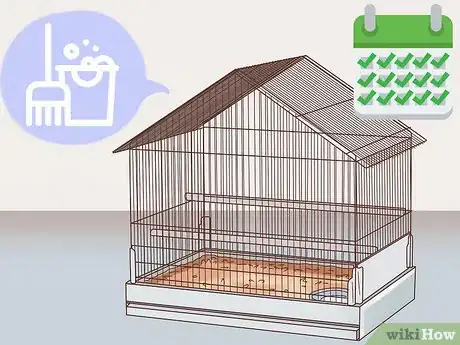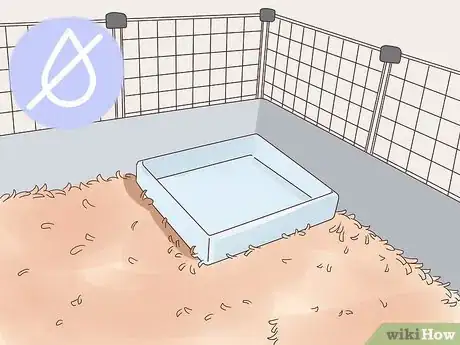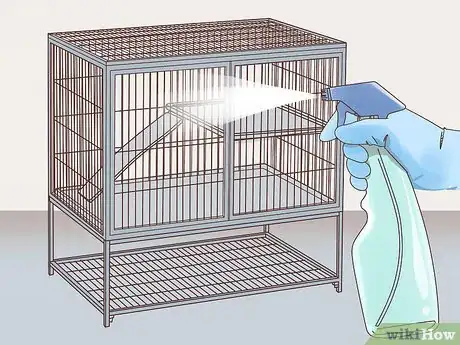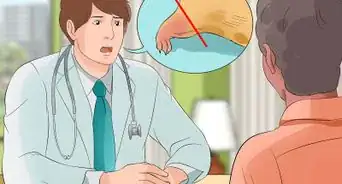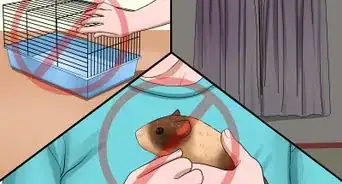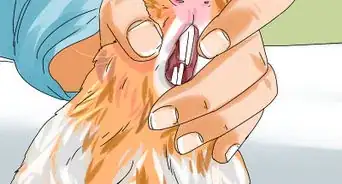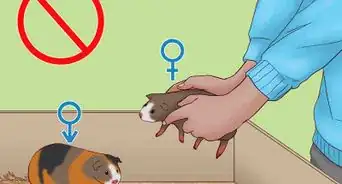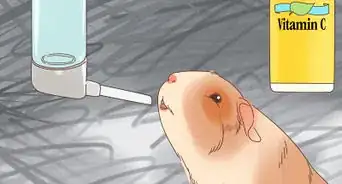This article was co-authored by Pippa Elliott, MRCVS. Dr. Elliott, BVMS, MRCVS is a veterinarian with over 30 years of experience in veterinary surgery and companion animal practice. She graduated from the University of Glasgow in 1987 with a degree in veterinary medicine and surgery. She has worked at the same animal clinic in her hometown for over 20 years.
This article has been viewed 53,612 times.
Ringworm is a fairly common problem in guinea pigs caused by fungus. It can be a painful condition for your pet, and it can spread to humans. Luckily, ringworm can usually be successfully treated with medication. If you suspect your guinea pig has a ringworm infection, seek an official diagnosis from a vet right away. From there, follow a care regimen to nurse your guinea pig back to health.
Steps
Seeking Veterinary Assistance
-
1Recognize the symptoms. Bald patches are the first and most obvious signs of ringworm. The fungus weakens the hair follicle, which then causes their fur to fall out. Bald patches will develop a crusty appearance with time and will eventually be accompanied by red patches around the eyes, ears, and nose.[1]
-
2Find a vet who can treat guinea pigs. Not all vets treat guinea pigs, as they are sometimes considered exotic animals. If you don't already have a vet, look online or in the local yellow pages to find a vet with experience treating guinea pigs.
- If you know any other guinea pig owners, try asking them for a recommendation.
Advertisement -
3Let your vet diagnose the condition. Ringworm is typically diagnosed by a physical examination followed up by taking a skin sample for analysis. While lab results may take a few days, if your vet is confident that the bald patches are cased by ringworm, you can usually begin treatment right away.[2]
-
4Talk over a treatment plan with your vet. Ringworm is treated with antifungal medication. It's administered over five to six weeks. Make sure you go over the recommended dosages carefully with your vet. If your guinea pig has a lot of bald patches, your vet may also prescribe creams to be applied topically.[3]
-
5Discuss payment. Vet bills can sometimes be pricey, so make sure you know how much treatment will cost. Ask whether you need to pay upfront or if you can pay with an installment plan. Some vets are happy to let owners make payments over time.
Managing Ringworm at Home
-
1Medicate your guinea pig. Give your guinea pig any antifungal medication prescribed by your vet at the correct dosages and times. Usually, medication is administered orally.[4]
- Liquid medications are typically given via a syringe. You gently hold up the guinea pig's head, insert the tip of the syringe just behind its front teeth, and then squeeze out the medication.[5]
- For pills, it's easiest to crush up the medication and mix it into a portion of food you know your guinea pig will eat. Just make sure your guinea pig eats all the food that contains its pills.
-
2Increase your guinea pig's vitamin C intake. Vitamin C can help strengthen your guinea pig's immune system and help it fight off ringworm. The best way to give your guinea pig vitamin C is to add a supplement to its water or to feed it vegetables high in vitamin C, like kale, mustard greens, and spinach.[6]
- While you can give your guinea pig pellets enriched with Vitamin C, these may lose their effectiveness quickly after the bag is opened.
-
3Treat bald patches. Bald patches may cause guinea pigs a lot of skin irritation. Your vet may prescribe an antifungal ointment to rub into your guinea pig's skin.[7]
- Talk to your vet about how much of the ointments to use, as well as for instructions for proper application.
- Never use an antifungal cream unless it's prescribed by your vet.
-
4Separate infected guinea pigs. If you have more than one guinea pig, get a separate cage for your infected pig. Ringworm is highly contagious and you do not want the infection to spread.[8]
- Clean the cage after separating your guinea pig from your other pigs.
- Make sure to keep your guinea pig's current cage clean to help stop the infection. Clean up any spills and urine promptly, as a wet environment breeds ringworm.
-
5Protect yourself from ringworm. Ringworm can spread to humans, so it's important to take precautions to protect yourself. Use gloves when handling anything in your guinea pig's cage. Wash your hands after holding your guinea pig. Do not kiss your guinea pig or hold it too close to your mouth.[9]
Preventing a Reoccurrence
-
1Clean the cage regularly. As ringworms come from fungus, keeping your guinea pig's cage clean keep ringworms at bay.[10] Once a week, do an extensive cleaning of your guinea pig's cage. Wash down the interior of the cage, as well as any washable toys and dishes, with biodegradable soap and water and replace things like beddings and chips.[11]
-
2Keep the environment dry. In addition to a thorough weekly cleaning, maintain a dry environment by routine tidying up each day. Ringworms tend to thrive in moist environments. Remove any wet patches of chips or bedding each day and watch out for patches of urine and water spills.[12]
-
3Sanitize toys and equipment. After cleaning your guinea pig's cage, spritz the cage and any surfaces with a mixture of equal parts water and vinegar. This naturally sanitizes the cage, which helps minimize exposure to ringworm. Rinse the solution thoroughly after applying it.[13]
-
4Keep the guinea pig quarantined until the infection passes. Treatment usually lasts seven to 10 days. After 10 days have passed, make a follow-up appointment with your vet to make sure your guinea pig is ringworm free. As soon as you get confirmation from your guinea pig is healthy, you can put it back in the cage with your other pigs.[14]
References
- ↑ https://www.pets4homes.co.uk/pet-advice/how-to-treat-ringworms-in-guinea-pigs.html
- ↑ https://www.pets4homes.co.uk/pet-advice/how-to-treat-ringworms-in-guinea-pigs.html
- ↑ http://www.petmd.com/exotic/conditions/skin/c_ex_gp_ringworm_infection?page=2
- ↑ http://www.petmd.com/exotic/conditions/skin/c_ex_gp_ringworm_infection?page=2
- ↑ http://www.petplace.com/article/small-mammals/general/nursing-care-for-sick-pets/how-to-medicate-your-guinea-pig
- ↑ http://www.humanesociety.org/animals/guinea_pigs/tips/guinea_pig_food_choices.html
- ↑ http://www.petmd.com/exotic/conditions/skin/c_ex_gp_ringworm_infection?page=2
- ↑ https://www.pets4homes.co.uk/pet-advice/how-to-treat-ringworms-in-guinea-pigs.html
- ↑ http://animals.mom.me/can-ringworm-guinea-pig-1863.html
- ↑ http://animals.mom.me/can-ringworm-guinea-pig-1863.html
- ↑ http://animals.mom.me/should-clean-guinea-pigs-cage-10761.html
- ↑ http://animals.mom.me/can-ringworm-guinea-pig-1863.html
- ↑ http://animals.mom.me/can-ringworm-guinea-pig-1863.html
- ↑ http://www.petmd.com/exotic/conditions/skin/c_ex_gp_ringworm_infection?page=2
About This Article
To treat ringworm in guinea pigs, start by taking your guinea pig to the vet for evaluation and treatment options. The vet will probably prescribe an antifungal medication to be administered over the course of 5-6 weeks, and possibly a topical cream to treat bald patches. If you have more than one guinea pig, it's important to separate them until the ringworm infection passes to prevent it from spreading. Since ringworm can also spread to humans, be sure to use gloves when handling your guinea pig and cleaning its cage. For tips from our Veterinary co-author on administering medications to guinea pigs, read on!
